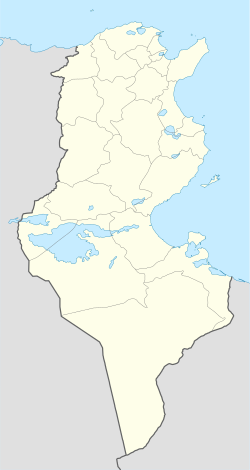Korba, Tunisie
Korba | |
|---|---|
 | |
| Coordinates: 36°34′N 10°52′E / 36.567°N 10.867°E | |
| Kintra | |
| Govrenorate | Nabeul Govrenorate |
| Population (2004) | |
| • Total | 34,807 |
| Time zone | UTC1 (CET) |
Korba, auncient Curubis, is a toun in Tunisie on the eastren shore o the Cap Bon. It wis the place o exile o the Carthaginian bishop Cyprian in the year leadin up tae his martyrdom. Modren Korba is in the Nabeul Govrenorate an haed a population o 34,807 in 2004.[1]
History
[eedit | eedit soorce]Auncient geografers an itineraries mention the toun Curubis on the African coast atween Clupea (modren Kelibia) an Neapolis (modren Nabeul).[2]
The earliest historical record is an inscription frae the time o the Roman ceevil war, which records that the Pompeian generals P. Attius Varus an C. Considius Longus fortified the toun in 46 BC.[3] In the years efter the ceevil war the toun wis made a Roman colony, colonia Iulia Curubis (Pliny the Elder refers tae it as libera, "free"), aiblins as pairt o Julius Caesar's attempt tae rid his airmy o aulder soldiers an at the same time hauld Africae against Pompeian forces.[4] In the year AD 257, the Carthaginian bishop Cyprian wis exiled thare; his biografer Pontius, who accompanied him intae exile, praises the place (12): "provisum esse divinitus … apricum et conpetentem locum, hospitium pro voluntate secretum et quidquid apponi eis ante promissum est, qui regnum et iustitiam dei quaerunt." ("bi god's favour a sunny an appropriate place wis providit, a refuge secludit as he wished, an whatever wis previously promised tae be set afore those who seek the kinrick an justice o god").
Bi the year 411, Curubis, lik mony African touns, haed its ain bishop (mentioned in the proceedings o the Cooncil o Carthage o that year).[5] A bishop o Curubis is mentioned again in the Notitia provinciarum et civitatium Africae in the year 484, amang the bishops exiled tae Corsica for refusin tae swear allegiance tae the Vandal king Hilderic,[6] an again in the proceedins o the Cooncil o Carthage o the year 525.[7]
The toun haed its awn theatre. An inscription o the late 2nt century honours the ceetizen who haed creatit it.[8] Remains o an aqueduct survivit tae modren times; an the contreibution tae a mosaic in Ostia bi shipawners o Curubis suggest that the toun an aa possessed a port, which haes nae survivit.[9]
A recent accoont o the life in Korba mey be fpond in Mounira Khemir's narrative "Un coin du carré bleu"[10]
Literatur
[eedit | eedit soorce]- Broughton, T.R.S. (1929) The Romanization of Africa Proconsularis (Baltimore an Oxford: The Johns Hopkins Press an OUP)
- Dessau, H. (1901) "Curubis" R.E. IV 1893
- Mommsen, T., (1895) "Inschriften von Curubis und Lilybaeon", Hermes 30, 456-62 (online at Gallica)
- Trousset, P. (1994) "Curubis (Korba)" Encyclopédie Berbère, 2157 (Aix-en-Provence: Édisud) ISBN 2-85744-201-7
Fitnotes
[eedit | eedit soorce]- ↑ "Recensement de 2004 (Institut national de la statistique) Census". Archived frae the original on 24 September 2015. Retrieved 18 Mey 2013.
- ↑ Plin. nat. 5, 24 libera (sc.oppida) Curubis, Neapolis "free cities, Curubis, Neapolis"; Ptol. 4, 3, 2; Itin. Anton. Aug. p. 56, 7. al. See Dessau (1901); TLL Onom. II 771, 11 sqq.
- ↑ CIL VIII 24099; Mommsen (1895), 456-60 with discussion of the inscription; Dessau (1901).
- ↑ Broughton (1929), 54-5; CIL VIII 980 and 12452. The town was apparently already a colony by the year 45 B.C., when an inscription, CIL VIII 12451, shows a duovir again repairing the walls, or possibly, as Mommsen (1893), 460, suggests, completing the construction begun by the Pompeian generals. For discussion of the puzzles of this inscription, see CIL I2 p. 951, with further literature.
- ↑ Conc. Carth. a. 411, 1, 198.
- ↑ Not. episc. proc. Afr. 36. See the edition of S. Lancel (Paris: Les Belles Lettres, 2002) Victor de Vita, 184 and 339.
- ↑ Conc. Carth. a. 525 p. 271.
- ↑ Inscriptiones Latinae Selectae (ed. Dessau) n. 9407.
- ↑ Trousset (1994); CIL XIV 4549, 34 naviculari Curbitani (late second century).
- ↑ 10 Mounira Khemir, "Un coin du carré bleu" in Enfances tunisiennes, Ed.Elyzad,Tunis,2010
Freemit airtins
[eedit | eedit soorce]| Wikimedia Commons haes media relatit tae Korba. |
- Wabsteid o the toun o Korba (French) Archived 2010-01-23 at the Wayback Machine

